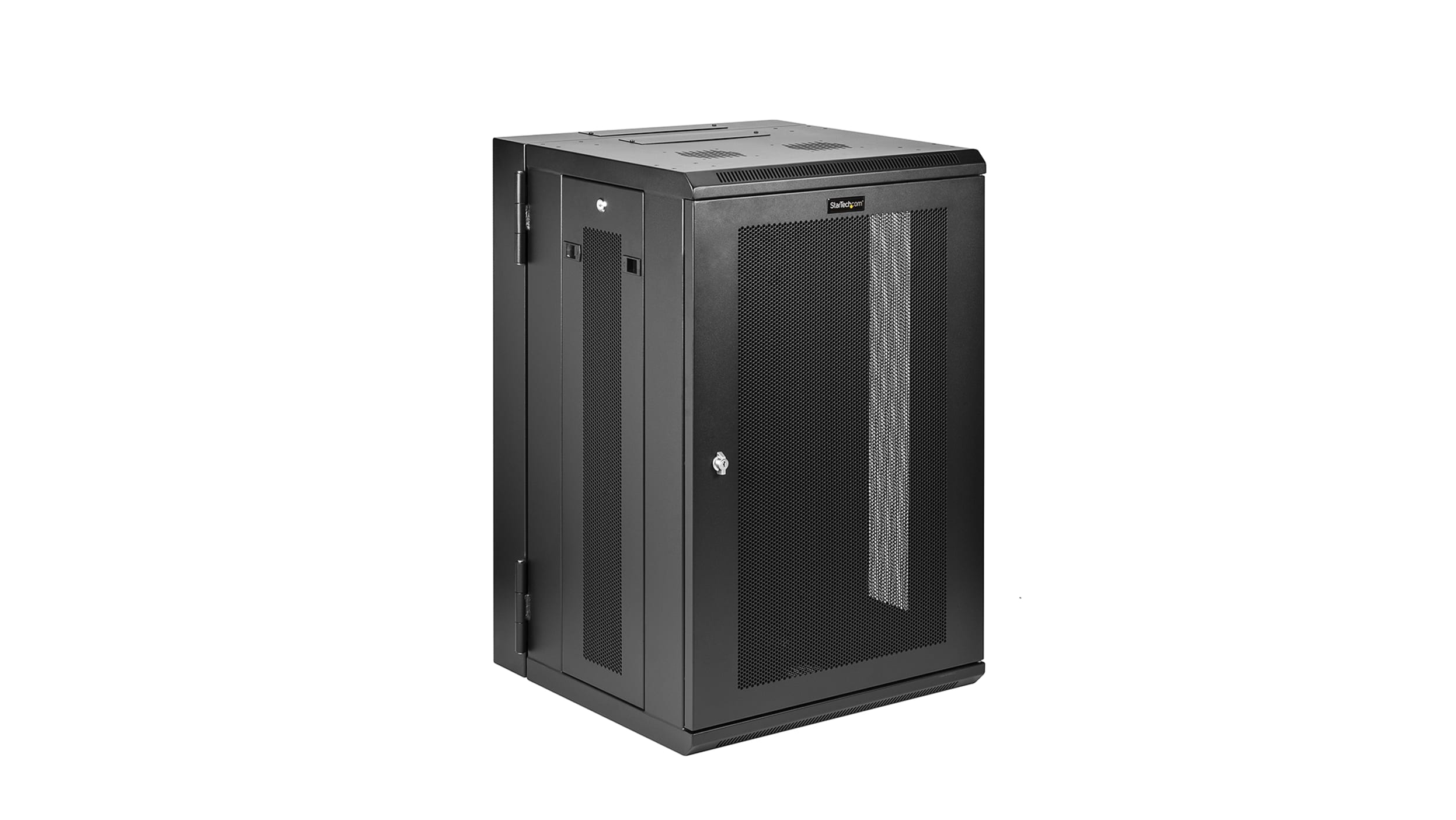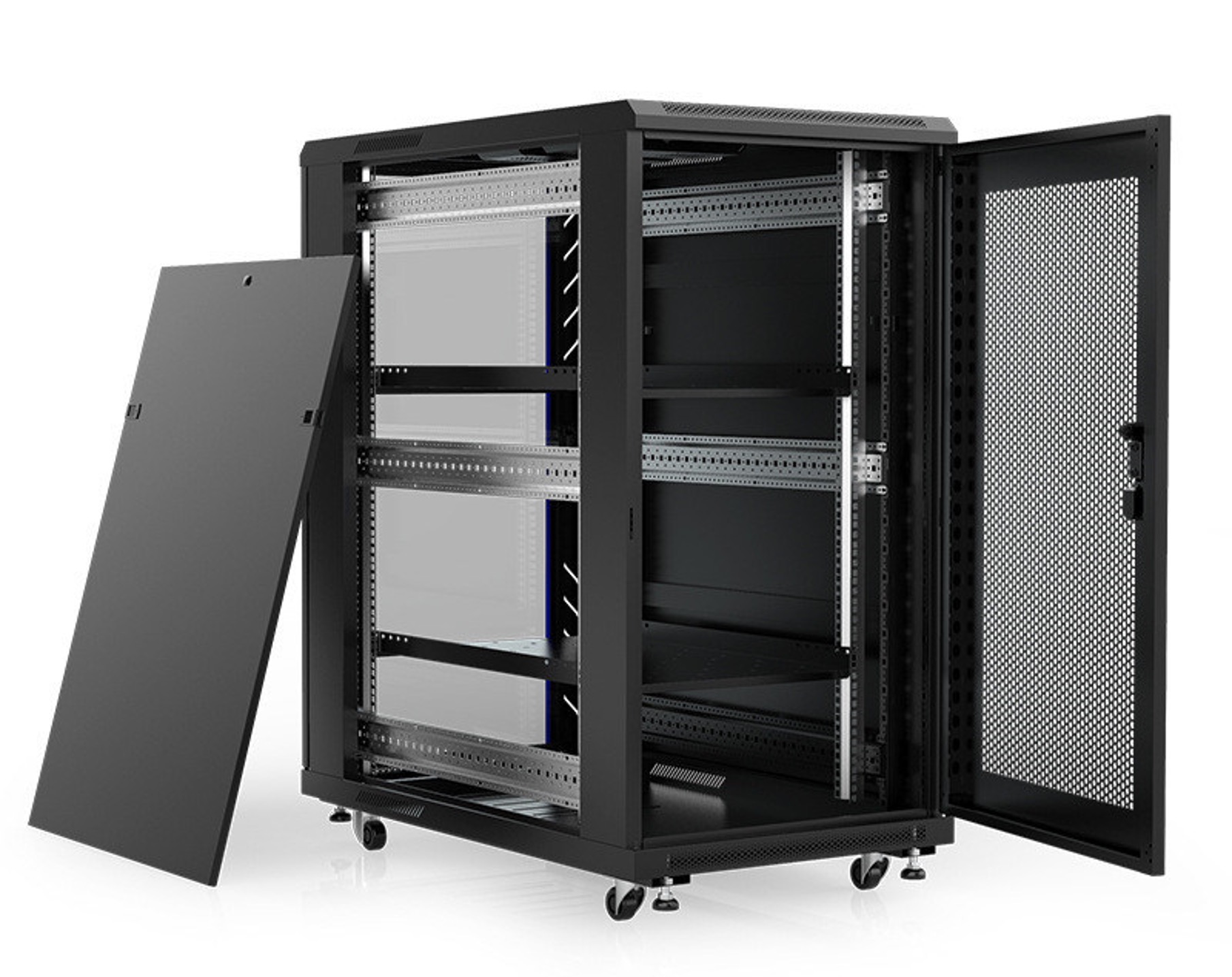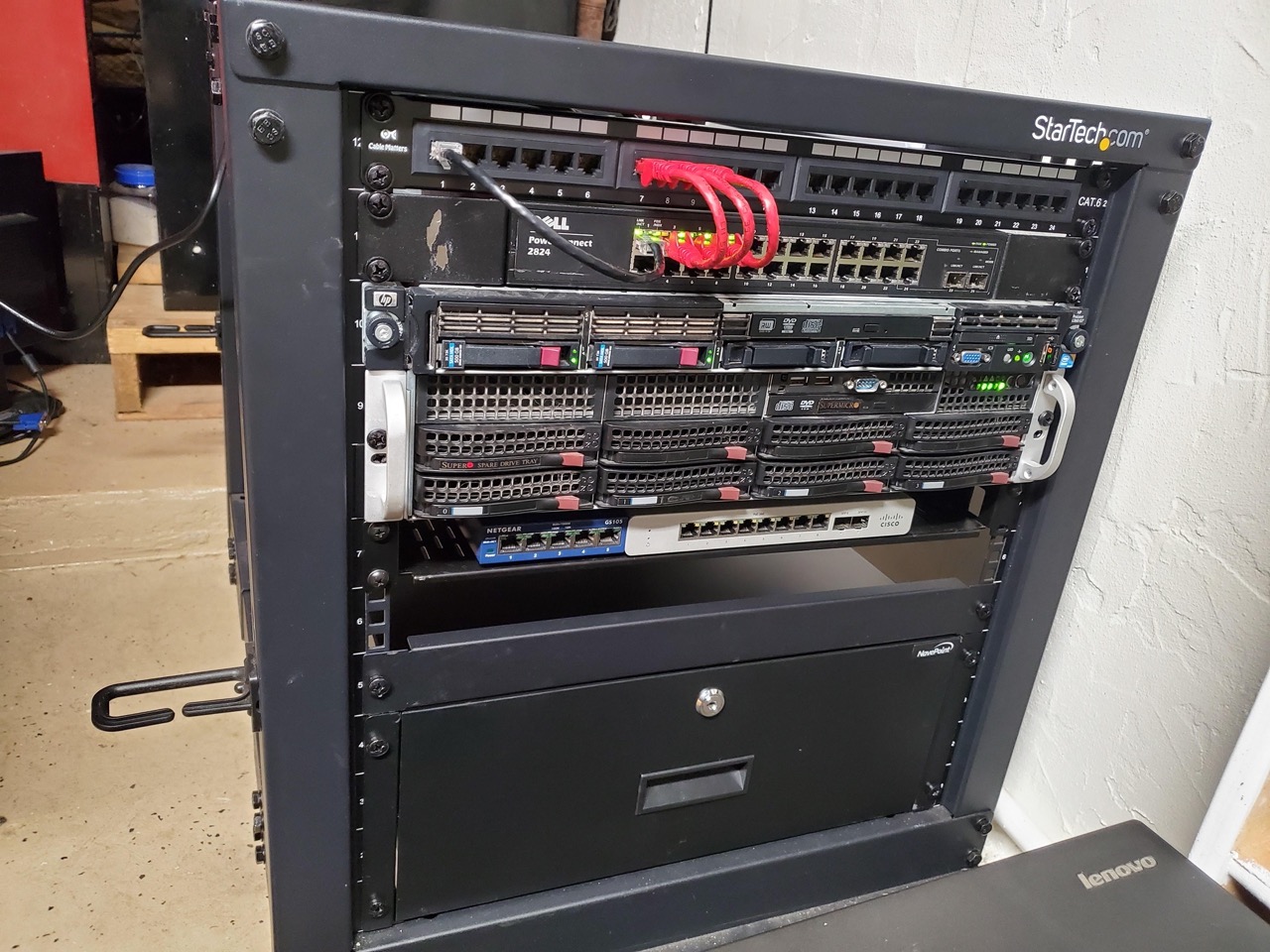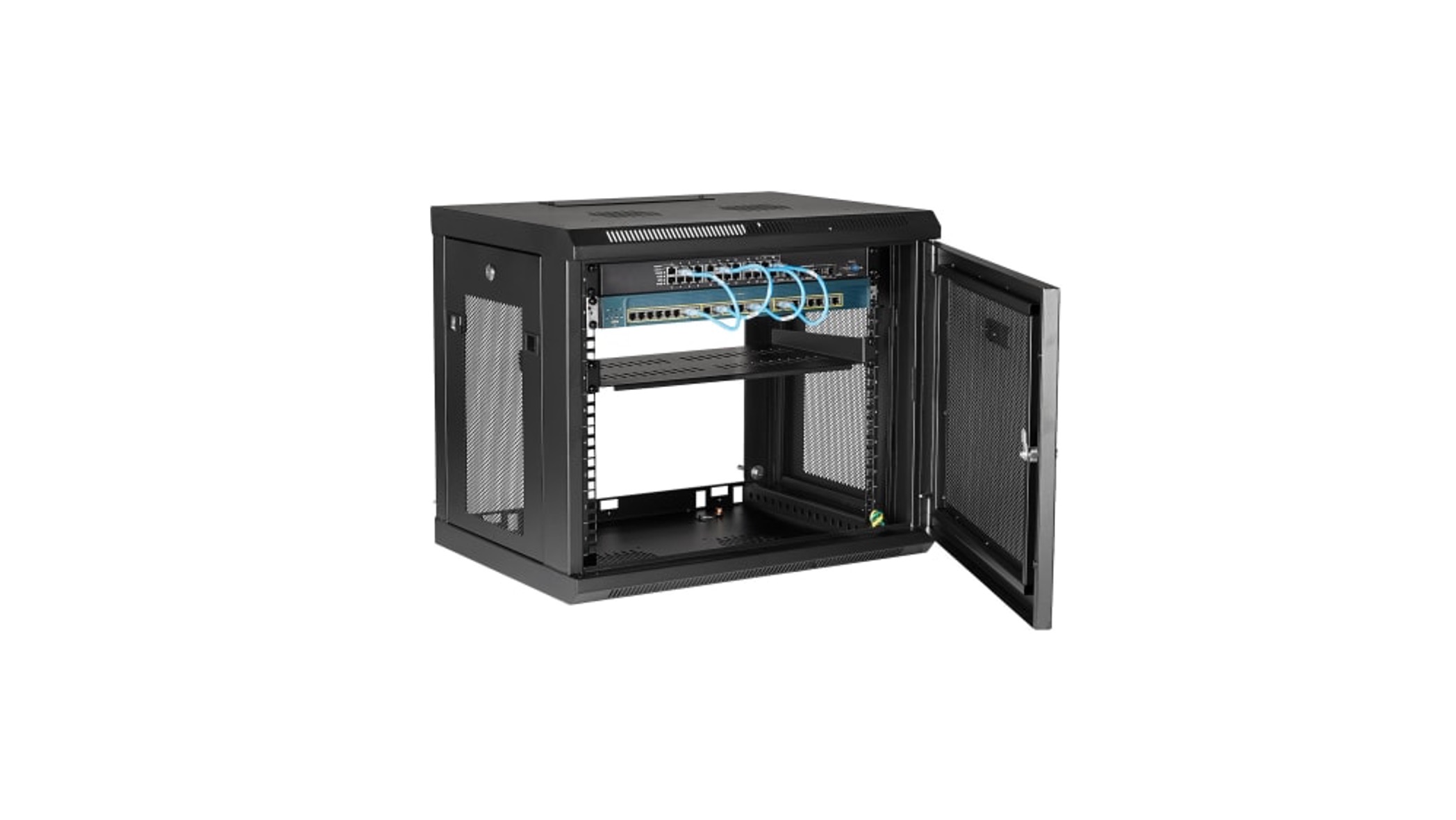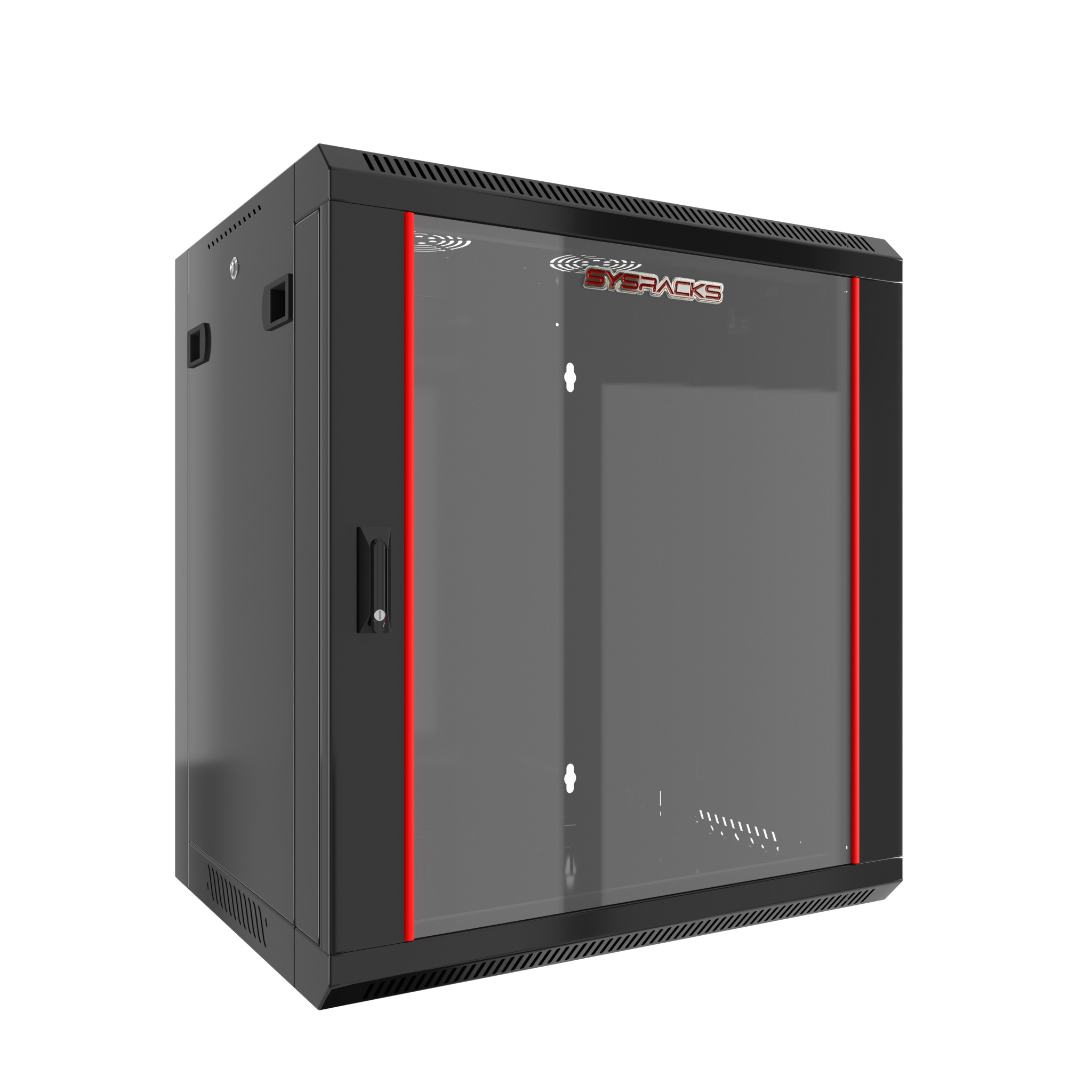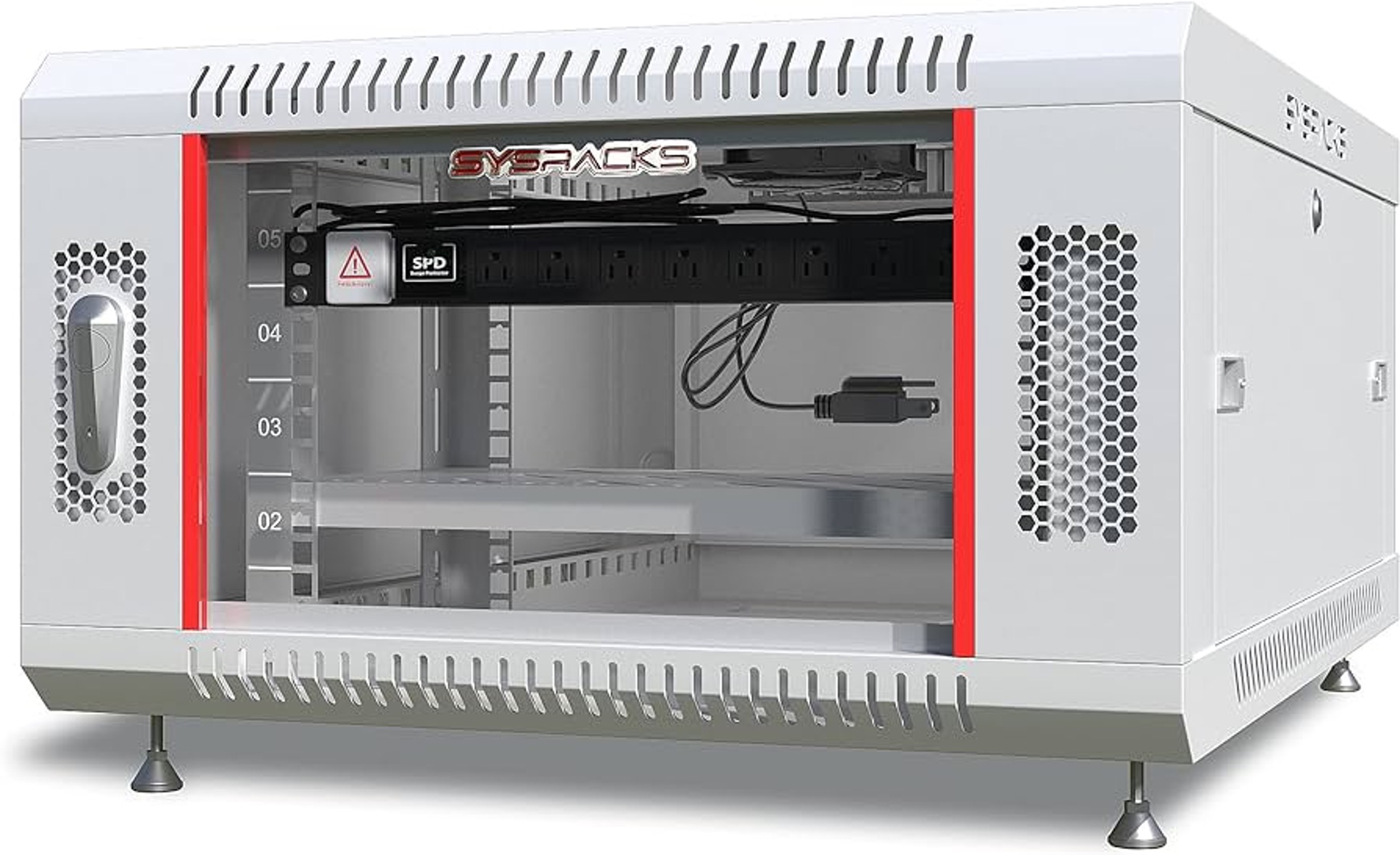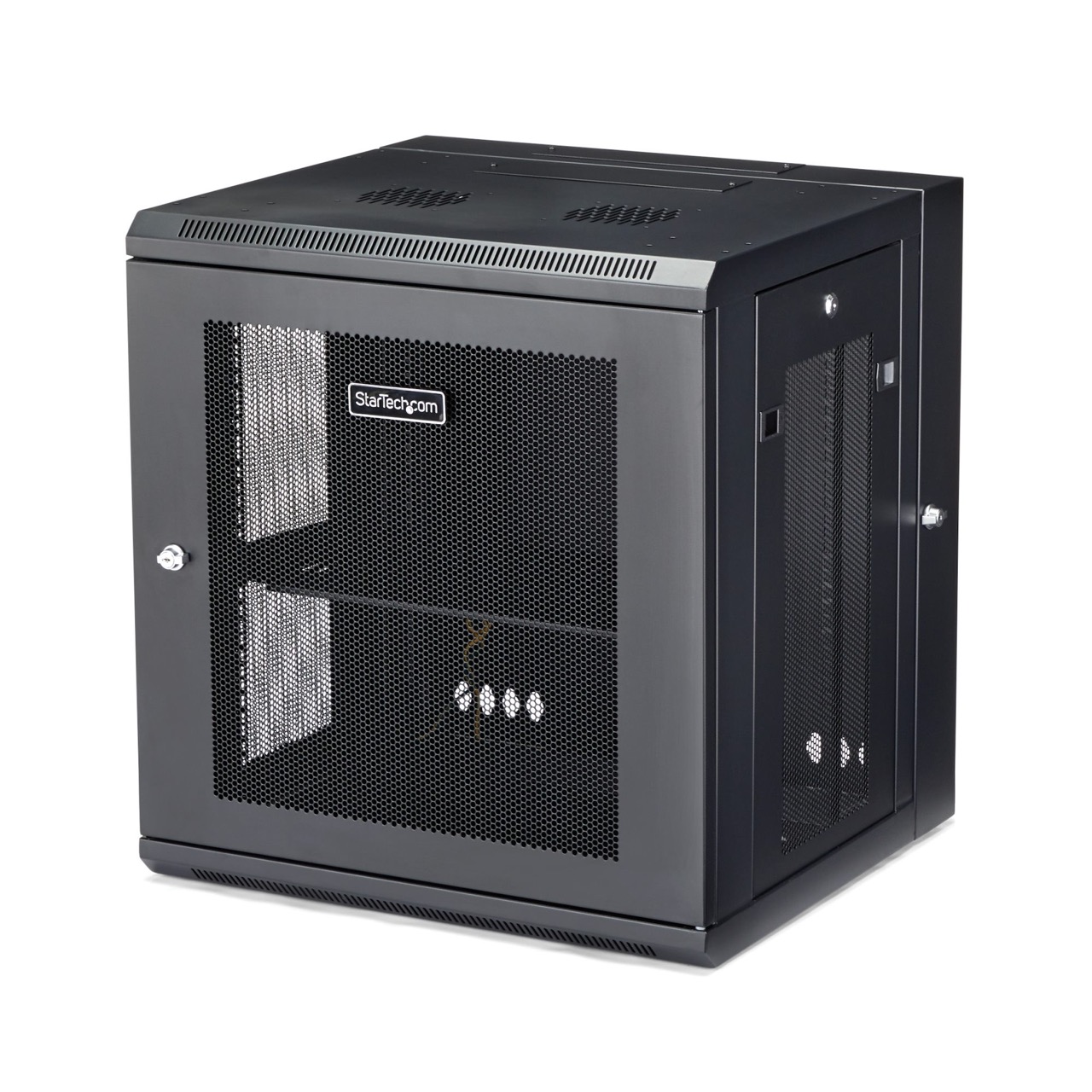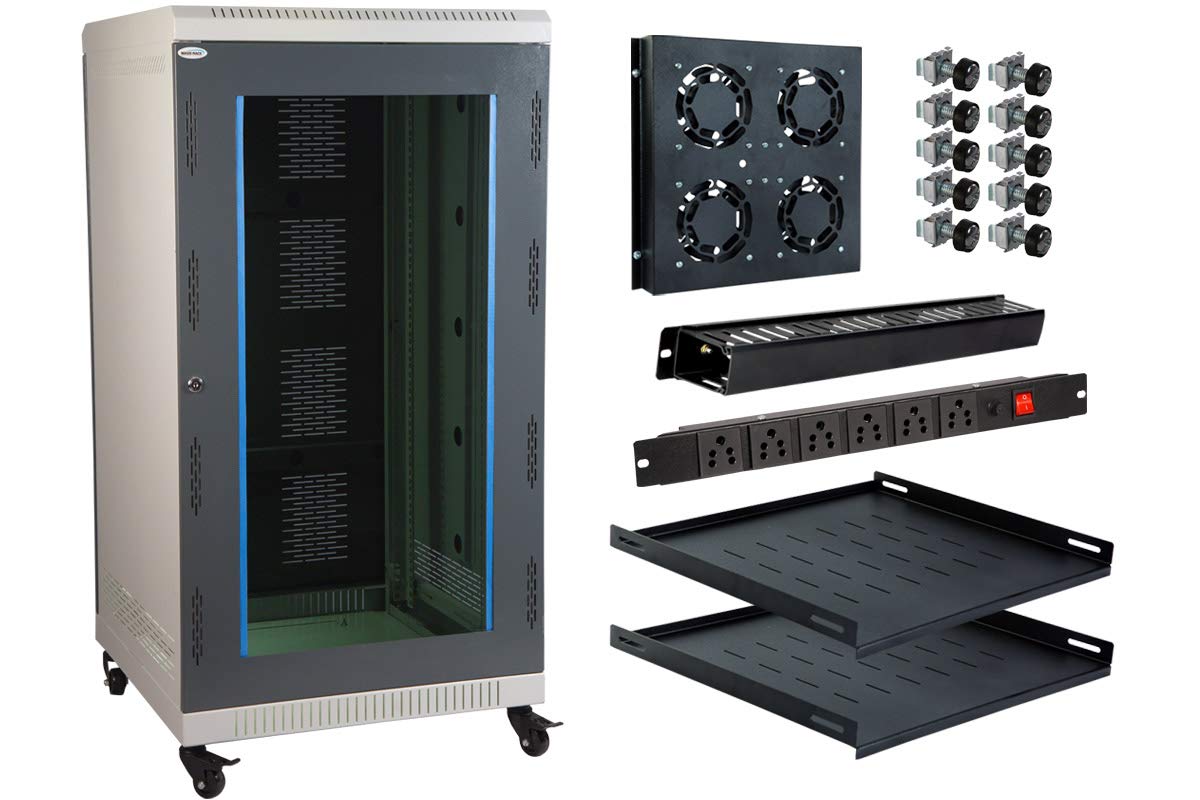Introduction
Welcome to the world of server racks! Whether you’re a seasoned IT professional or a curious tech enthusiast, understanding the components of a server rack is essential knowledge in this digital age. A server rack is a standardized enclosure designed to house and organize various networking and server equipment. It provides a secure and centralized location for these critical components, facilitating maintenance, scalability, and effective management of the IT infrastructure.
In this article, we will explore the different parts that make up a server rack, shedding light on their functions and importance. From the front panel to the doors, from the fans to cable management solutions, we’ll cover it all to give you a comprehensive understanding of this integral piece of equipment.
Server racks play a crucial role in data centers, offices, and even homes where a significant amount of computing power is required. They come in various sizes, allowing for customization and scalability to meet specific needs. Additionally, server racks are designed with an emphasis on proper airflow, cable management, security, and temperature control to ensure the reliable operation of the installed equipment.
Whether you’re planning to set up your own server rack or simply want to enhance your knowledge about IT infrastructure, this article will serve as a guide to the key components you’ll find in a typical server rack. So, let’s dive in and explore the exciting world of server racks!
Server Rack
The server rack is the main structure that houses all the components of the IT infrastructure. It provides a secure and organized environment for servers, switches, routers, and other networking equipment. Server racks have standardized dimensions, most commonly using the 19-inch width format. They are typically measured in units (U), with each unit equaling 1.75 inches in height.
The construction of a server rack involves durable materials such as steel or aluminum to withstand the weight and heat generated by the equipment. The rack is designed with ventilation and cable management features to ensure proper airflow and minimize cable clutter. Additionally, server racks often include locking mechanisms and other security features to protect the sensitive equipment they house.
Server racks can vary in size, ranging from compact options to accommodate a few servers to large-scale racks capable of housing dozens or even hundreds of devices. When choosing a server rack, it’s crucial to consider factors such as the available space, power requirements, cooling capabilities, and future scalability needs.
Some server racks are enclosed to provide added protection and security. This type of rack typically has front and rear doors that can be locked, preventing unauthorized access to the equipment. The doors are often solid or equipped with perforated panels to ensure proper airflow and temperature regulation.
Open-frame server racks, on the other hand, do not have doors and are suitable for environments where security is not a primary concern. These racks offer easy access to the equipment, making installation, maintenance, and troubleshooting more convenient.
Regardless of the type and size of the server rack, its primary purpose is to provide a centralized and organized space for the essential components that power our digital world. From small businesses to large data centers, server racks are the backbone of the IT infrastructure, ensuring the smooth operation of networks and systems.
Front Panel
The front panel of a server rack is the face that houses the majority of the equipment’s user interface and connectivity ports. It is the primary access point for administrators to interact with the installed devices. Let’s explore some of the key components found on the front panel of a server rack.
Starting from the top, you’ll often find a display panel or LED indicators that provide important information about the status of the equipment. These indicators can indicate power status, network connectivity, or other relevant system notifications. They serve as a quick visual reference for administrators to identify any potential issues.
Next, you’ll find the power buttons or switches for the devices. These buttons allow for easy power management, enabling administrators to turn individual servers or networking equipment on or off as needed. They help facilitate efficient energy consumption and ensure proper system operation.
Connectivity ports, such as Ethernet ports and USB ports, are also a common feature on the front panel. These ports provide direct access to the network and allow administrators to connect peripheral devices for configuration or maintenance purposes. They offer flexibility and convenience in managing the equipment within the server rack.
Another important component on the front panel is the drive bays. These bays are used to install hard drives or solid-state drives for data storage. They allow for easy expansion or replacement of storage devices without the need to access the rear panel of the server rack.
In addition to these core components, the front panel may include other features specific to the type of equipment housed in the server rack. This can include LCD panels for system monitoring, audio jacks for sound-related devices, or even specialized ports for custom applications.
The front panel is not only functional but also plays an aesthetic role in the overall design of the server rack. It is often designed with a professional and sleek appearance to create a visually appealing setup. This is particularly important for server racks located in office environments or data centers where appearances matter.
With its array of connectivity options and user-friendly interface, the front panel of a server rack provides easy access and control over the installed devices. It serves as the command center for administrators to monitor and manage the IT infrastructure efficiently.
Rear Panel
The rear panel of a server rack is just as crucial as the front panel, serving as the backbone for connectivity and power distribution. While it may not be as accessible as the front panel, it houses several essential components that ensure the smooth operation of the equipment. Let’s take a look at some key features found on the rear panel of a server rack.
One of the primary components on the rear panel is the power supply unit (PSU). The PSU supplies the necessary electrical power to the servers and networking devices installed in the rack. It is typically equipped with multiple outlets to connect various devices, ensuring they receive a stable and consistent power source.
Networking equipment, such as switches and routers, often have their ports located on the rear panel. These ports provide connectivity options for the devices within the server rack and facilitate communication between servers, network devices, and external networks. They are essential for creating and maintaining a reliable network infrastructure.
Cable management is another vital aspect of the rear panel. It includes features such as cable trays, cable clips, and cable management arms designed to organize and route the numerous cables running through the rack. Proper cable management helps maintain good airflow, avoids cable clutter, and eases troubleshooting and maintenance tasks.
Ventilation is critical to prevent overheating of the equipment. The rear panel of a server rack often contains perforated vents or fans to enable the airflow necessary to dissipate heat. These vents and fans help maintain an optimal temperature inside the rack, ensuring the longevity and reliability of the installed devices.
Additionally, the rear panel may feature expansion slots or expansion module bays. These slots allow for the installation of additional cards or modules to expand the capabilities of the equipment. This can include adding more network ports, storage interfaces, or specialized functionality to meet specific requirements.
Security is also a consideration on the rear panel of a server rack. Depending on the rack’s design and the environment it’s located in, the rear panel might include security features such as lockable doors or panels to prevent unauthorized access to the equipment and its connections.
The rear panel may also accommodate other components or accessories specific to the type of equipment housed in the server rack, such as KVM (keyboard, video, and mouse) switches or console ports for remote management and control.
The rear panel of a server rack may not be as visually appealing or accessible as the front panel, but it is the unsung hero that ensures efficient power distribution, connectivity, cooling, and cable management. It plays a vital role in maintaining the overall functionality and reliability of the server rack.
Side Panels
The side panels of a server rack are an often overlooked but essential component of the overall structure. While they may seem simple, they serve various crucial functions that contribute to the efficiency and security of the equipment housed within the rack. Let’s explore the significance of side panels in a server rack.
One of the primary functions of side panels is to provide physical protection and security for the devices installed in the rack. They serve as a barrier, preventing unauthorized access, tampering, or accidental damage to the equipment. By enclosing the sides of the rack, side panels add an extra layer of protection to sensitive and valuable components.
In addition to security, side panels also assist in creating a controlled environment within the server rack. By enclosing the sides, they contribute to improved airflow management, ensuring proper ventilation throughout the rack. This helps to prevent hot spots and maintain optimal operating temperatures for the equipment, enhancing overall performance and longevity.
Furthermore, side panels also aid in reducing noise levels. The enclosed design helps to contain the sound produced by the servers and other devices, minimizing noise pollution in the surrounding environment. This can be particularly beneficial in office or co-location environments where noise reduction is a priority.
Another notable function of side panels is cable management. Many server racks have built-in cable management features on the sides, such as punch-out holes or cable routing channels. These allow for organized routing and securing of cables, reducing clutter and simplifying maintenance and troubleshooting tasks.
When it comes to rack stability, side panels play a vital role. They provide additional structural integrity to the server rack, ensuring it remains sturdy and secure. The reinforced construction of side panels helps distribute the weight of the installed equipment evenly, preventing any potential imbalance or strain on the rack’s frame.
It’s important to note that not all server racks come with side panels. Some racks, particularly those used in data centers or server rooms with controlled access, may be open-frame or have removable side panels for easy accessibility during installation or maintenance.
In summary, while side panels may seem like a simple component of a server rack, they perform critical functions such as security, airflow management, noise reduction, cable management, and rack stability. These panels contribute to creating a controlled and secure environment for the equipment, ensuring optimal performance and longevity.
Rack Rails
Rack rails are an integral part of a server rack, providing the framework to mount and secure the equipment within the rack. These rails are essential for proper organization, stability, and easy access to the devices. Let’s delve into the significance of rack rails in a server rack.
The primary function of rack rails is to provide a standardized mounting system for the equipment. They feature a series of evenly spaced holes or slots along their length, allowing servers, switches, and other devices to be securely attached to the rack. The holes or slots typically follow the EIA-310 standard, ensuring compatibility and ease of installation.
Rack rails come in two main types: fixed or adjustable. Fixed rack rails have predetermined positions and are ideal for housing devices of similar sizes. Adjustable rack rails, on the other hand, provide flexibility by allowing the devices to be positioned at various depths within the rack. This is particularly useful when dealing with equipment of different sizes or when considering future expansion or reconfigurations.
One of the key advantages of rack rails is their ability to support the weight of the equipment. They are designed to handle the load and distribute it evenly across the rack structure. This ensures that the devices remain securely in place and guarantees the overall stability of the rack.
Rack rails also facilitate easy installation, removal, and maintenance of the equipment. Thanks to their design, devices can be easily slid in or out of the rack, providing convenient access for upgrades, repairs, or component replacement. This minimizes downtime and streamlines the management of the IT infrastructure.
Cable management is another crucial aspect that rack rails help address. Many rack rails come with built-in cable management features such as clips, hooks, or cable routing channels. These features allow for organized routing and securing of cables, reducing clutter, and simplifying troubleshooting and maintenance.
It is worth mentioning that rack rails are not only limited to servers and networking equipment. They can also accommodate other accessories such as shelves, trays, or patch panels, providing additional space for storage or connectivity options.
In summary, rack rails are essential components of a server rack, providing a sturdy framework for mounting and organizing the equipment. They ensure proper weight distribution, facilitate easy installation and maintenance, and contribute to efficient cable management. Rack rails play a vital role in creating a well-structured and functional server rack environment.
Doors
Doors are an important feature of server racks, providing both physical protection and access control for the equipment housed within. They help safeguard sensitive data and prevent unauthorized access, while also contributing to the overall functionality and organization of the rack. Let’s take a closer look at the significance of doors in a server rack.
One of the primary purposes of server rack doors is to enhance security. By enclosing the front and/or rear sections of the rack, the doors act as a barrier, preventing unauthorized individuals from tampering with or stealing the equipment. They provide an additional layer of protection, particularly in settings where physical security is a concern, such as data centers or server rooms that require restricted access.
Doors can be made from various materials, including steel or tempered glass. Steel doors provide enhanced physical protection, while glass doors add visibility, allowing administrators to monitor the equipment without opening the door. In some cases, doors may also feature perforated or mesh panels, allowing for ventilation while maintaining security.
In addition to security, doors have a practical role in maintaining proper airflow and temperature control within the server rack. They are often designed with perforated panels or vents, allowing for adequate ventilation. This helps prevent the buildup of heat and ensures that the equipment operates within acceptable temperature limits, optimizing performance and reliability.
Doors also aid in reducing noise levels. By covering the front and/or rear of the rack, they act as sound barriers, minimizing the noise emitted by the equipment. This is particularly beneficial in environments where noise reduction is crucial, such as office spaces or areas with limited sound insulation.
Another important aspect of server rack doors is their role in providing convenient access for maintenance and troubleshooting. They can be designed with hinges, latches, or quick-release mechanisms, allowing administrators to easily open and close the doors when needed. This makes it simpler to perform tasks like installing or replacing components, routing cables, or conducting routine maintenance procedures.
It is worth noting that different types of server racks have varying door configurations. For example, some racks may have front doors only, while others may have both front and rear doors. Additionally, certain racks may have doors that are fully solid, while others may feature reinforced glass panels or perforated mesh designs.
In summary, doors in a server rack offer vital security, ventilation, and accessibility benefits. They protect the equipment from unauthorized access, maintain proper airflow, attenuate noise levels, and provide an accessible entry point for maintenance and troubleshooting. The design and configuration of the doors depend on specific needs, ensuring that the server rack meets the required level of security and functionality.
Fans
Fans play a crucial role in the cooling system of a server rack, helping to maintain optimal operating temperatures for the installed equipment. These essential components serve to dissipate heat generated by servers and other devices, ensuring reliable performance and preventing overheating. Let’s explore the significance of fans in a server rack.
The primary function of fans in a server rack is to facilitate airflow and cooling. As the equipment within the rack operates, it generates heat. Without proper cooling, the temperature can rise to levels that may cause malfunctions or even permanent damage to the devices. Fans help expel hot air from the rack and draw in cooler air, maintaining a balanced temperature within the enclosure.
Fans are strategically placed within the server rack to ensure efficient airflow. They may be mounted on the rear panel, front panel, or even within the rack itself, depending on the rack’s design. These fans often have a specific airflow direction and can be configured to create a consistent airflow pattern, ensuring all the equipment receives adequate cooling.
The size and speed of the fans are important considerations. Larger fans typically move more air and are generally quieter than smaller fans at the same RPM. However, the number and size of fans may vary depending on the specific cooling requirements of the server rack and the equipment it houses. The goal is to achieve a sufficient airflow rate to keep the components within their operating temperature limits.
Some server racks include fan control mechanisms to adjust fan speed based on temperature or load. This helps optimize energy consumption and noise levels while still ensuring effective cooling. Additionally, fan filters may be installed to prevent dust and debris from entering the rack, reducing the risk of component damage and improving the overall lifespan of the equipment.
In certain environments, such as data centers or rooms with limited ventilation, server racks may require additional cooling solutions. This can include the use of precision air conditioning systems or liquid cooling technologies alongside fans to maintain precise temperature control.
Proper maintenance of fans is essential to ensure their effectiveness and longevity. Dust accumulation can reduce airflow and impair the cooling capacity of the fans. Regular cleaning and inspection of the fans and their surrounding areas are necessary to keep them running efficiently.
In summary, fans are essential components in a server rack’s cooling system. They ensure proper airflow, expel hot air, and maintain the optimal operating temperature for the installed equipment. Fans play a critical role in preventing overheating, ensuring reliable performance, and extending the lifespan of the devices within the server rack.
Cable Management
Cable management is a crucial aspect of maintaining an organized and efficient server rack environment. It involves proper routing, securing, and organizing the cables that connect the various devices within the rack. Effective cable management offers numerous benefits, including improved airflow, simplified maintenance, and reduced troubleshooting time. Let’s delve into the significance of cable management in a server rack.
One of the key advantages of cable management is improved airflow. Properly organized cables allow for better airflow within the server rack, preventing the buildup of heat and ensuring a consistent temperature throughout. This promotes optimal performance and reliability of the equipment, as overheating can lead to reduced efficiency and potential malfunctions.
Cable management also simplifies maintenance and troubleshooting tasks. Neatly arranged cables make it easier for administrators to identify and access specific connections, reducing the time required to identify and resolve issues. Additionally, well-organized cables minimize the risk of accidental disconnections or damage during maintenance procedures.
Effective cable management enhances scalability and flexibility. By keeping cables organized, it becomes easier to add or remove devices from the server rack. This allows for more efficient expansion or reconfiguration of the IT infrastructure as needs change, without the hassle of tangled or undistinguishable wires.
Another benefit of cable management is enhanced visual appeal. A neatly organized server rack not only simplifies maintenance and troubleshooting but also gives a professional and organized appearance. This is particularly beneficial in environments such as data centers or server rooms where appearances matter.
There are various cable management solutions available for server racks. These may include cable trays, cable routing channels, cable ties or straps, and cable management arms. Cable trays provide a space to route and organize cables, whereas routing channels keep cables separate and prevent them from tangling. Cable ties or straps keep cables secured and organized, while cable management arms allow for easy routing and adjustment of cables.
It’s important to consider future scalability when implementing cable management. Planning for future expansion and ensuring sufficient space for additional cables will help maintain an organized setup as the infrastructure grows.
Furthermore, it’s recommended to label or document cables to easily identify their purpose or destination. This can save valuable time during troubleshooting or when making changes to the configuration.
In summary, cable management is a vital aspect of maintaining an efficient and well-organized server rack environment. It improves airflow, simplifies maintenance and troubleshooting, enhances scalability, and contributes to a professional appearance. By investing time and effort into effective cable management, administrators can ensure a reliable and organized IT infrastructure within the server rack.
Power Distribution Unit (PDU)
A Power Distribution Unit (PDU) is a vital component in a server rack that helps manage and distribute power to the connected devices. It serves as a centralized power source, providing a safe and reliable means to deliver electricity to servers, switches, and other networking equipment. Let’s explore the significance of PDUs in a server rack.
The primary function of a PDU is to distribute electrical power to the devices within the server rack. PDUs are equipped with multiple outlets and are typically connected to the main power source. They ensure that each device receives a stable and regulated power supply, minimizing the risk of power fluctuations or overloads.
PDUs offer various features to facilitate efficient power management. Some PDUs are equipped with individual power switches, allowing administrators to turn servers or specific sections of the rack on or off as needed. This enables effective energy management and ensures that power is only directed to the devices that require it.
Additionally, PDUs often have built-in surge protection and circuit breakers to safeguard the connected equipment against power spikes or shorts. These protective features help prevent damage to valuable devices, ensuring their longevity and uninterrupted operation.
There are different types of PDUs available, including basic PDUs, metered PDUs, and intelligent PDUs. Basic PDUs provide a straightforward power distribution without any additional monitoring or control capabilities. Metered PDUs offer the ability to measure and monitor power usage on each outlet, providing valuable insights into energy consumption.
Intelligent PDUs, also known as smart PDUs, take power management to the next level. They offer advanced features such as remote monitoring, outlet-level control, and environmental sensors. Intelligent PDUs enable administrators to remotely monitor power usage, receive alerts on potential power issues, and maintain greater control over the equipment’s power status.
Cable management is often integrated into PDUs, with features such as cable routing channels and cable clips. These ensure organized routing and securing of power cables, reducing clutter and improving overall rack management.
It’s important to consider the power capacity and compatibility when selecting a PDU. The power capacity should meet the requirements of the devices connected to the rack, and the PDU should be compatible with the power distribution standards in the specific region.
In summary, the Power Distribution Unit (PDU) plays a crucial role in managing and distributing power within a server rack. It ensures safe and reliable power delivery to the connected devices, offers power management features, and provides protection against power anomalies. By selecting the right PDU and employing effective power management practices, administrators can optimize energy efficiency, enhance equipment reliability, and streamline the operation of the IT infrastructure within the server rack.
Mounting Hardware
Mounting hardware is an essential component of a server rack, enabling the secure installation of equipment within the rack. It consists of various screws, nuts, bolts, and other fasteners specifically designed for mounting servers, switches, and other devices. Let’s explore the significance of mounting hardware in a server rack.
The primary purpose of mounting hardware is to securely attach the equipment to the rack rails. The hardware ensures that the devices remain in place, even during transportation or when subjected to vibrations or movements. Without proper mounting hardware, the equipment could shift or become dislodged, leading to potential damage or disruptions in operation.
Mounting hardware typically includes screws and cage nuts, which are used to secure devices to the rack rails. The screws are inserted through the mounting holes on the equipment and fastened into the cage nuts, which are then inserted into the square holes on the rack rails. This locking mechanism provides a reliable and sturdy connection between the rack and the equipment.
When installing devices, it’s crucial to use the appropriate size and type of mounting hardware. The size of the screws and cage nuts should match the equipment’s mounting holes and the rack’s mounting rails. Mismatches in size or type can cause improper fitting or loose connections, compromising the stability and security of the mounting.
Mounting hardware also enables flexibility within a server rack. With the proper hardware, devices can be easily added, removed, or rearranged within the rack, allowing for efficient configuration changes or future expansion. This flexibility enables IT administrators to adapt the rack to evolving needs and optimize the layout for improved accessibility and cable management.
It’s important to note that different manufacturers or models may require specific types of mounting hardware. Some equipment may use captive screws or sliding rails for easy installation and removal, while others may have unique mounting mechanisms. It’s crucial to consult the manufacturer’s guidelines or documentation to ensure the correct mounting hardware is used.
In addition to securing equipment, mounting hardware also assists in cable management within the rack. Some hardware may have built-in cable management features, such as hooks or loops, to route and secure cables, reducing clutter and improving overall organization.
Regular inspection and maintenance of mounting hardware are necessary to ensure its effectiveness. Over time, screws can become loose, and cage nuts may need tightening to maintain a secure connection. Regular checks and adjustments help prevent any potential issues or accidents due to insecure mounting.
In summary, mounting hardware is a crucial component of a server rack, providing secure connections between the equipment and the rack rails. It enables flexibility, facilitates proper cable management, and ensures the stability and reliability of the IT infrastructure within the rack. By using the correct mounting hardware and performing regular maintenance, administrators can create a secure and well-organized server rack environment.
Shelves and Trays
Shelves and trays are valuable additions to a server rack, providing additional space for equipment, storage, or other accessories. They offer a practical solution for organizing devices that may not fit onto the rack rails or require a flat surface for placement. Let’s explore the significance of shelves and trays in a server rack.
Shelves and trays provide a stable and secure surface for devices that are unable to be mounted directly onto the rack rails. They can hold equipment that lacks mounting holes or is not designed for rack-mounted installation. This includes items such as modems, routers, or smaller network components that require a flat surface for proper placement within the rack.
One of the main advantages of shelves and trays is their versatility. They can be easily adjusted or repositioned within the rack to accommodate different equipment or changing needs. This flexibility allows for efficient use of rack space, as devices can be added, removed, or rearranged without the need for complex installation.
Shelves and trays can also serve as storage areas within the server rack. They provide space for storing miscellaneous tools, spare parts, or other smaller accessories that are essential for the maintenance and operation of the IT infrastructure. This helps keep the rack organized and reduces the risk of misplacement or loss of important components.
Cable management is another benefit of using shelves and trays. Many models come with built-in cable management features, such as holes or clips, allowing for proper routing and securing of cables. This helps maintain a tidy and organized rack environment, preventing cable clutter and simplifying maintenance and troubleshooting tasks.
When choosing shelves and trays, it’s important to consider factors such as weight capacity and size. Different models have varying weight limits, so it’s crucial to ensure that the selected shelf or tray can support the equipment or items to be placed on it. Additionally, the size of the shelf or tray should align with the available rack space and the dimensions of the equipment or items it will hold.
It’s also worth noting that some shelves and trays are designed for specific purposes, such as vented shelves for improved airflow or sliding trays for easy access to equipment. These specialized options offer additional functionality based on the specific needs of the server rack setup.
In summary, shelves and trays are versatile components that add functionality and convenience to a server rack. They provide a sturdy and adjustable surface for non-rack-mountable devices, offer storage space, aid in cable management, and contribute to overall organization. By incorporating suitable shelves and trays, administrators can optimize the use of rack space and enhance the efficiency of their server rack setup.
Blanking Panels
Blanking panels, also known as filler panels or blank panels, are an often overlooked but essential component in a server rack. They are designed to cover empty spaces or unused rack units to optimize airflow, improve cooling efficiency, and enhance the overall functionality of the server rack. Let’s explore the significance of blanking panels in a server rack.
The empty spaces or unused rack units in a server rack can create airflow inefficiencies. Without proper airflow management, cool air can bypass the equipment, resulting in hot spots and inadequate cooling. Blanking panels are specifically designed to cover these gaps, ensuring that the airflow is directed through the active devices, improving cooling performance, and maintaining consistent temperatures within the rack.
By using blanking panels to seal off empty spaces, negative air pressure is reduced. This prevents the recirculation of hot air from the rear to the front of the rack, allowing the cooling system to work more efficiently. Proper airflow management helps prevent overheating and increases the reliability and longevity of the equipment housed within the server rack.
In addition to improving airflow, blanking panels contribute to better cable management within the rack. By covering unused rack units, they create a flat surface, facilitating the organization and routing of cables. This not only reduces cable clutter but also simplifies maintenance and troubleshooting tasks by providing easy access to active devices.
Blanking panels also offer physical protection to the interior of the rack. They act as a barrier, preventing foreign objects, dust, or debris from entering the rack and causing damage or clogging the equipment. This added layer of protection helps to maintain the cleanliness and reliability of the server rack environment.
It’s important to note that blanking panels come in various sizes to fit different rack units. They can be easily installed and removed, allowing for flexible configuration changes or future expansion. Some advanced blanking panels are even designed with adjustable airflow vents, allowing for fine-tuning of the cooling system based on specific equipment requirements.
While blanking panels may seem like a small detail, their impact on the overall operation of the server rack should not be underestimated. A well-organized and properly cooled rack leads to improved performance, energy efficiency, and reduced risk of equipment failure.
When installing blanking panels, it’s important to ensure they are compatible with the rack’s dimensions and airflow requirements. Proper placement and coverage of the empty spaces are essential to maximize their effectiveness in improving airflow and cooling efficiency within the rack.
In summary, blanking panels are crucial components in a server rack that optimize airflow, improve cooling efficiency, aid in cable management, and provide physical protection. By strategically using blanking panels, administrators can create a well-controlled and reliable environment for the equipment housed within the server rack.
Grounding
Grounding is a critical aspect of setting up a server rack and ensuring the safe and reliable operation of the equipment within. Grounding involves establishing an electrical connection between the rack and the ground, providing a path for electrical current to safely dissipate in the event of a fault or surge. Let’s explore the significance of grounding in a server rack.
The primary purpose of grounding in a server rack is to protect against electrical shocks and equipment damage. By connecting the rack to a reliable ground, any unwanted electrical charges or surges are effectively directed away from the equipment and safely dispersed into the ground. This helps protect both individuals working with the rack and the sensitive electronic devices from electrical hazards.
Grounding also helps to maintain consistent electrical potential across the rack and its components. By ensuring that all equipment within the rack is at the same reference voltage level, grounding mitigates the risk of electrical noise or potential differences that could interfere with the proper functioning of the equipment. This contributes to the stability and reliability of the IT infrastructure.
In addition to safety and stability, grounding aids in lightning protection. A properly grounded server rack provides a safe path for lightning strikes or power surges to dissipate to the ground, minimizing the risk of damage to the equipment and reducing downtime caused by electrical disturbances.
There are several key elements when it comes to grounding a server rack. These include:
- Grounding Conductor: This is the physical wire that connects the rack to the grounding system. It should be of appropriate size and material, ensuring low resistance and effective conductivity.
- Grounding Bar: A grounding bar is used to connect multiple grounding conductors together. It is typically installed within the rack’s grounding system, providing a centralized point for all connections.
- Grounding Lug: This is used to connect the grounding conductor to the grounding bar or other grounding points in the rack. It is essential to ensure a secure and reliable connection.
- Grounding System: The grounding system includes the various elements, such as grounding rods or grounding plates, that provide a direct path for electrical current to flow into the ground.
Proper installation and regular maintenance of the grounding system are crucial to ensure its effectiveness. Periodic inspections should be performed to ensure that all connections are secure and that the grounding conductors and components are free from damage or corrosion.
It’s important to adhere to local electrical codes and regulations when implementing grounding in a server rack setup. Consulting with a qualified electrician or following industry best practices can help ensure that the grounding system meets the necessary standards and requirements.
By implementing proper grounding practices, administrators can provide a safe operating environment for the equipment within the server rack, reduce the risk of electrical hazards, and enhance the overall reliability and performance of the IT infrastructure.
Security Features
Security is a paramount concern when it comes to server racks, as they often house valuable and sensitive equipment. To protect against unauthorized access and tampering, server racks are equipped with various security features. These features play a crucial role in safeguarding the equipment and ensuring the integrity of the IT infrastructure. Let’s explore the significance of security features in a server rack.
One of the primary security features of a server rack is the use of locked doors. These doors are designed to restrict access to the equipment housed within the rack. The doors are typically made of durable materials, such as steel or tempered glass, and are equipped with reliable locking mechanisms. This helps prevent unauthorized individuals from physically accessing the rack and tampering with or stealing the equipment.
In addition to locked doors, server racks may incorporate other security measures such as biometric or keycard access control systems. These systems require authorized individuals to present their unique credentials or access cards to gain entry to the rack. This provides an additional layer of security, limiting access only to authorized personnel and keeping a log of individuals who enter the rack.
Server racks may also feature sensors or alarms to alert administrators in case of unauthorized access or tampering. These sensors can detect physical vibrations, changes in temperature, or even the opening of the rack doors. If any unusual activity is detected, the alarm system is triggered, enabling immediate response and investigation.
Some server racks also come with built-in environmental monitoring systems. These systems can detect factors such as temperature, humidity, and airflow within the rack. By monitoring and alerting administrators to any changes or anomalies in these environmental conditions, the security and reliability of the equipment within the rack can be better maintained.
Cable management can also be considered a security feature in a server rack. Well-managed cables reduce the risk of accidental disconnections or damage to the equipment. It also helps to identify any unauthorized changes or connections within the rack, as any cables that are not properly routed or secured can be quickly identified and investigated.
It’s important to note that while server rack security features provide a level of protection, they should be complemented by additional physical and network security measures. Establishing proper access control policies, implementing firewalls and intrusion detection systems, and regular security audits are essential to ensure comprehensive protection of the IT infrastructure.
In summary, security features are vital components of a server rack setup. Locked doors, access control systems, sensors, alarms, and environmental monitoring systems help prevent unauthorized access, detect tampering or unusual activity, and maintain the security and integrity of the equipment. By implementing effective security measures and adopting best practices, administrators can minimize the risk of security breaches and ensure the safety of the IT infrastructure housed within the server rack.
Temperature and Environmental Controls
Temperature and environmental controls are crucial aspects of maintaining the optimal operating conditions within a server rack. Proper control and management of temperature, humidity, and other environmental factors are essential for ensuring the reliable performance and longevity of the equipment. Let’s explore the significance of temperature and environmental controls in a server rack.
Maintaining the appropriate temperature is critical to the operation of the equipment within a server rack. Excessive heat can cause components to overheat, leading to reduced performance, shortened lifespan, and potential hardware failures. On the other hand, excessively low temperatures can also impact the efficient functioning of certain devices. Temperature control systems, such as cooling fans, forced air systems, or liquid cooling solutions, ensure that the equipment remains within the recommended temperature range, optimizing performance and reliability.
In addition to temperature, humidity control is equally important. Excessive humidity can lead to condensation, which can cause corrosion and damage to sensitive electronic components. On the other hand, very low humidity can result in electrostatic discharges that can harm the equipment. An optimal humidity range is typically maintained within the server rack to prevent these issues and create a stable operating environment for the equipment.
Proper airflow management is a critical part of temperature and environmental control. Ensuring a consistent flow of cool air through the rack helps dissipate heat generated by the equipment. Strategic placement of fans, vents, and perforated panels helps create an efficient airflow path, preventing hot spots and maintaining optimal temperatures within the rack.
Environmental monitoring systems are commonly implemented within server racks to continuously measure temperature, humidity, and other factors such as smoke, water, or air quality. These systems provide real-time data and alerts to administrators, enabling them to identify any potential issues or anomalies promptly. With these monitoring systems in place, administrators can proactively respond to environmental changes and take necessary actions to prevent equipment damage or downtime.
Modern server racks often include intelligent control systems that automatically adjust temperature and airflow based on real-time conditions and equipment demands. These systems can adjust fan speed, cooling capacity, or even route airflow to specific areas of the rack as needed. This dynamic control not only optimizes performance but also saves energy by ensuring resources are directed where they are most needed.
The location of the server rack also plays a role in temperature and environmental control. Placement in a proper environment, away from excessive heat sources or direct sunlight, is essential to maintaining efficient operation. Adequate clearance around the rack allows for proper airflow and heat dissipation.
Regular maintenance and cleaning of the server rack are critical to ensuring effective temperature and environmental control. Dust or debris accumulation can obstruct airflow and impair heat dissipation, leading to increased temperatures within the rack. Regular inspections, cleaning, and replacing air filters, as well as keeping the surrounding area clean, help maintain optimal temperature and environmental conditions.
In summary, temperature and environmental controls are vital components of a server rack setup. Proper management of temperature, humidity, and airflow ensures the reliable operation and longevity of the equipment housed within. Monitoring systems and intelligent control mechanisms enable proactive responses to environmental changes, maintaining optimal conditions and preventing damage or downtime. By implementing effective temperature and environmental controls, administrators can create a stable and efficient environment for the IT infrastructure within the server rack.
Conclusion
Server racks are the foundation of an organized and efficient IT infrastructure, providing a secure environment for housing servers, switches, and other networking equipment. The various components that make up a server rack work together to ensure optimal performance, reliable operation, and ease of management. From the front panel to the rear panel, from the mounting hardware to the security features, each component plays a crucial role in creating a functional and secure server rack environment.
The front panel serves as the access point, providing user interfaces, connectivity options, and power controls. The rear panel houses the power supply unit (PSU), networking ports, cable management solutions, and ventilation for effective airflow. Side panels and doors contribute to security, airflow management, and noise reduction. Fans and temperature controls help maintain appropriate temperatures and prevent overheating. Cable management solutions organize and route cables, reducing clutter and simplifying maintenance. Power distribution units (PDUs) distribute electricity safely and efficiently. Mounting hardware ensures secure installation of equipment. Shelves and trays provide additional storage and flexibility. Blanking panels optimize airflow and cable management. Grounding protects against electrical hazards. Security features safeguard against unauthorized access and tampering. Finally, temperature and environmental controls maintain optimal conditions for equipment performance.
In conclusion, understanding the different components of a server rack is essential for efficient organization, effective management, and optimal performance of the IT infrastructure. By taking into account these components and their functions, administrators can design and maintain server racks that meet the specific needs of their organization. With proper implementation, a well-designed and properly managed server rack will contribute to a reliable, secure, and robust IT infrastructure, ensuring the smooth operation of critical systems and services.









